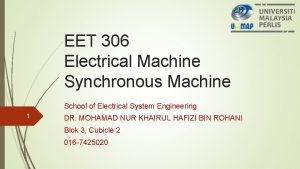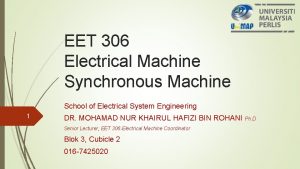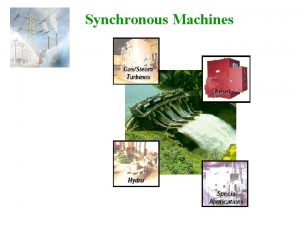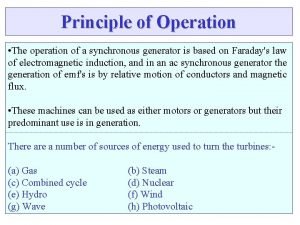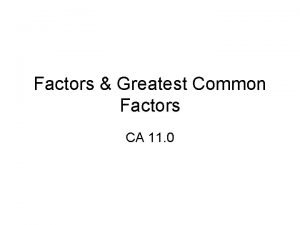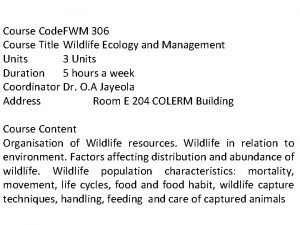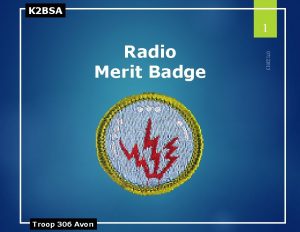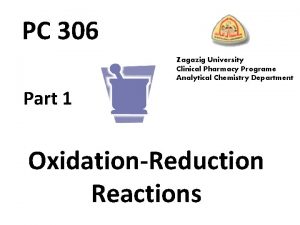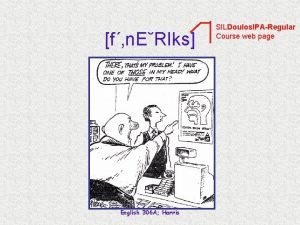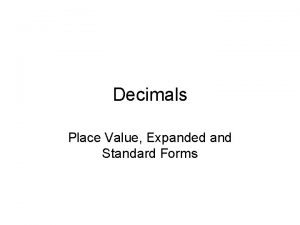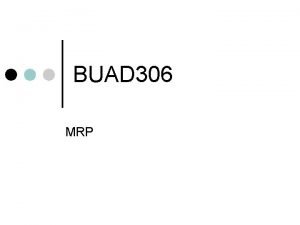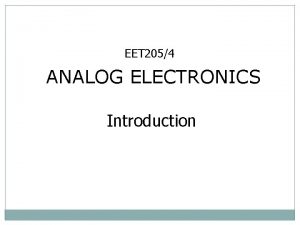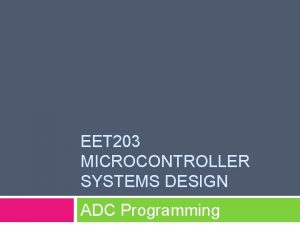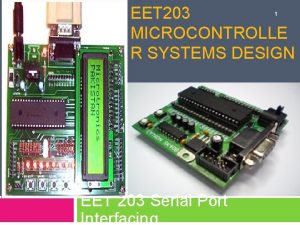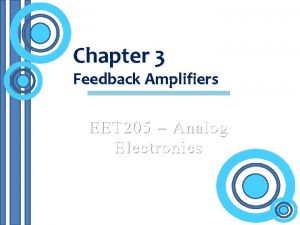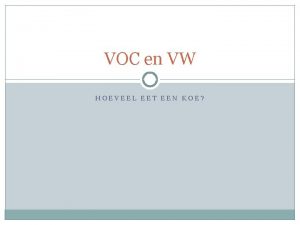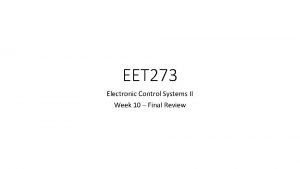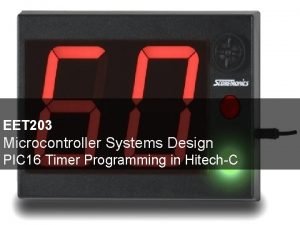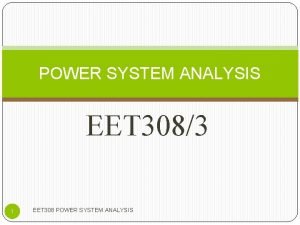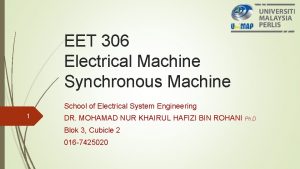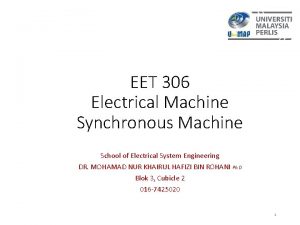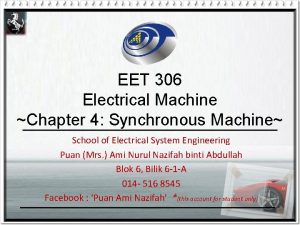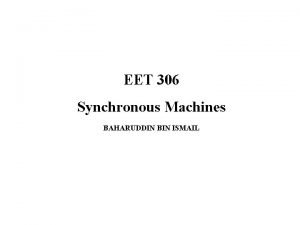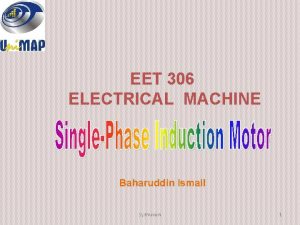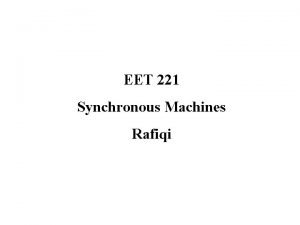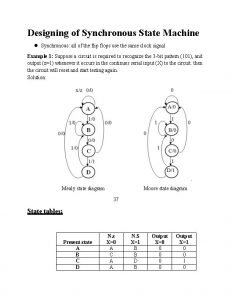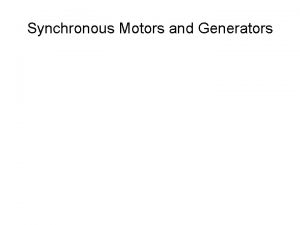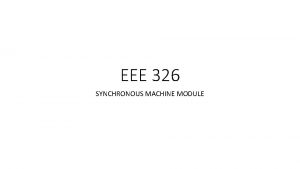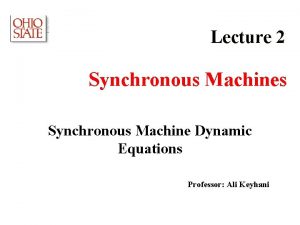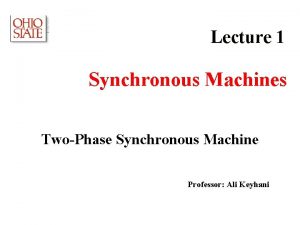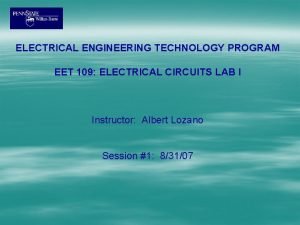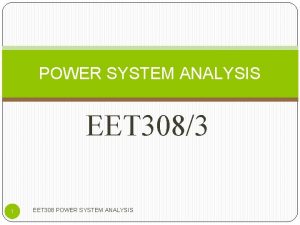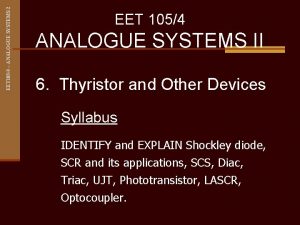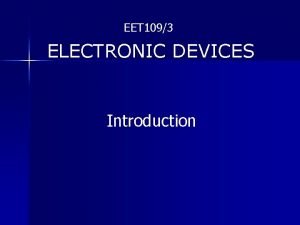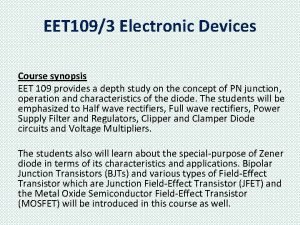EET 306 Electrical Machine Synchronous Machine School of






































- Slides: 38

EET 306 Electrical Machine Synchronous Machine School of Electrical System Engineering 1 DR. MOHAMAD NUR KHAIRUL HAFIZI BIN ROHANI Blok 3, Cubicle 2 016 -7425020

Chapter 4: Synchronous machine 2 4. 1 4. 2 Sync. G : Constructional features & operation theory 4. 1. 1 Introduction 4. 1. 2 Salient pole rotor generators 4. 1. 3 Non-salient pole rotor generators 4. 1. 4 Different between Salient and Non-Salient pole generator 4. 1. 5 Principle Operation Sync. G : Basic parameter 4. 2. 1 Speed of rotation 4. 2. 2 Internal generated voltage 4. 2. 3 Equivalent circuit 4. 2. 4 Voltage regulation / Phasor diagram 4. 2. 5 Measuring model parameters 4. 3 Sync. G : Parallel operation of AC Generators 4. 4 Sync. M : Principle operation

4. 1 Sync. G : Constructional features & operation theory 4. 1. 4 ADDITIONAL DIFFERENT BETWEEN SALIENT AND NONSALIENT NON-SALIENT Poles are sticking out from the Unslotted portion of cylinder surface. acts as poles. Concentrated winding on the poles and a uniform air gap One distributed winding and essentially uniform air gap Mechanically weak, prime mover used are water turbines, IC engines Mechanically strong, prime mover used are steam turbines, electric motor AMI NURUL NAZIFAH ABDULLAH

4. 2 Sync. G : Basic Parameter 4. 2. 1 SPEED OF ROTATION, nm Synchronous means by ‘electrical frequency produced is locked in or synchronized with the mechanical rate of rotation of the machine’. The rate of rotation of the magnetic fields is related to the stator electrical frequency; Where; fe = electrical frequency [Hz] nm = mechanical speed of the magnetic field [rpm] P = number of poles AMI NURU L NAZIFA H ABDUL LAH

4. 2 Sync. G : Basic Parameter EXAMPLE 4. 1 i. Calculate the speed of rotation of a ∆-connected synchronous machine that has 200 k. VA, 480 V, 60 Hz, and the number of pole is six. [1200 rpm] ii. What is the number of pole for a Y-connected synchronous generator if its terminal voltage is 480 V, electric power is generated at 50 Hz and the rotor must turn at 25 rps? [4 poles] 5

Chapter 4: Synchronous machine 6 4. 1 4. 2 Sync. G : Constructional features & operation theory 4. 1. 1 Introduction 4. 1. 2 Salient pole rotor generators 4. 1. 3 Non-salient pole rotor generators 4. 1. 4 Different between Salient and Non-Salient pole generator 4. 1. 5 Principle Operation Sync. G : Basic parameter 4. 2. 1 Speed of rotation 4. 2. 2 Internal generated voltage 4. 2. 3 Equivalent circuit 4. 2. 4 Voltage regulation / Phasor diagram 4. 2. 5 Measuring model parameters 4. 3 Sync. G : Parallel operation of AC Generators 4. 4 Sync. M : Principle operation

4. 2 Sync. G : Basic Parameter 4. 2. 2 INTERNAL GENERATED VOLTAGE, EA The magnitude of the voltage induced in a stator phase is; • This voltage depend on: The flux, Ф in the machine The frequency or speed of rotation The machine’s construction • Where 00 OR For ω in electrical rad/sec. f = flux distribution NC = no of conductors at an angle of a constant representing the construction of the machine For ω in mechanical rad/sec. 1 electrical radians = (p / 2) x mechanical radian

Chapter 4: Synchronous machine 8 4. 1 4. 2 Sync. G : Constructional features & operation theory 4. 1. 1 Introduction 4. 1. 2 Salient pole rotor generators 4. 1. 3 Non-salient pole rotor generators 4. 1. 4 Different between Salient and Non-Salient pole generator 4. 1. 5 Principle Operation Sync. G : Basic parameter 4. 2. 1 Speed of rotation 4. 2. 2 Internal generated voltage 4. 2. 3 Equivalent circuit 4. 2. 4 Voltage regulation / Phasor diagram 4. 2. 5 Measuring model parameters 4. 3 Sync. G : Parallel operation of AC Generators 4. 4 Sync. M : Principle operation

4. 2 Sync. G : Basic Parameter 4. 2. 3 EQUIVALENT CIRCUIT However, this internal generated voltage, EA is not usually the voltage that appears at the terminals, VT of the generator. There are many factors that cause the difference between EA and output voltage from a phase, VФ. 1. The distortion of the air gap magnetic field by the current flowing in the stator, called armature reaction, Xa or X. 2. The self inductance of the armature coils, Xl or XA. 3. The stator resistance of the armature coils, Ra or RA. 4. The effect of salient pole rotor shapes. ignored due to minor error compare to nonsalient pole.

4. 2 Sync. G : Basic Parameter 4. 2. 3 EQUIVALENT CIRCUIT (Cont’d) With the Factor 1. (armature reaction), the output voltage on a phase is

4. 2 Sync. G : Basic Parameter 4. 2. 3 EQUIVALENT CIRCUIT (Cont’d) With the Factor 2. (self inductance) and 3. (stator resistance), the output voltage on a phase respectively is Combine the armature reaction effects and the self inductance in the machine, called as synchronous reactance, XS So,

4. 2 Sync. G : Basic Parameter 4. 2. 3 EQUIVALENT CIRCUIT (Cont’d) Thus, EA is differ from VФ by the resistive and inductive voltage drop. Simplified; Xs = X +XA synchronous reactance Zs = RA+ j. XS synchronous impedance

4. 2 Sync. G : Basic Parameter 4. 2. 3 EQUIVALENT CIRCUIT (Cont’d) The Per Phase Equivalent Circuit of a Synchronous Generator

4. 2 Sync. G : Basic Parameter 4. 2. 3 EQUIVALENT CIRCUIT (Cont’d) If the machine is Wye (Y) connection: The voltage across the ac line, VL or VT is equal to multiplied by the voltage across the phase windings, VФ ; The line currents, IL are equal to the phase current I Ф or IA.

4. 2 Sync. G : Basic Parameter 4. 2. 3 EQUIVALENT CIRCUIT (Cont’d) If the machine is Delta (Δ) connection: The line voltage, VL or VT is equal to the phase voltage, VФ ; The line currents, IL are equal to multiplied by the phase current I Ф or IA.

Chapter 4: Synchronous machine 16 4. 1 4. 2 Sync. G : Constructional features & operation theory 4. 1. 1 Introduction 4. 1. 2 Salient pole rotor generators 4. 1. 3 Non-salient pole rotor generators 4. 1. 4 Different between Salient and Non-Salient pole generator 4. 1. 5 Principle Operation Sync. G : Basic parameter 4. 2. 1 Speed of rotation 4. 2. 2 Internal generated voltage 4. 2. 3 Equivalent circuit 4. 2. 4 Voltage regulation / Phasor diagram 4. 2. 5 Measuring model parameters 4. 3 Sync. G : Parallel operation of AC Generators 4. 4 Sync. M : Principle operation

4. 2 Sync. G : Basic Parameter 4. 2. 4 VOLTAGE REGULATION & PHASOR DIAGRAM q Phasor Diagram. The voltage in synchronous generator are ac voltages, so usually expressed as phasors. Phasors has both magnitude and angle expressed in 2 D plot. Phasor diagram is to show the relationship between Voltages within a phase ( EA, VФ , j. XSIA, and RAIA) Current IA in the phase

4. 2 Sync. G : Basic Parameter 4. 2. 4 VOLTAGE REGULATION & PHASOR DIAGRAM q Phasor Diagram (Cont’d). Take V Ф = V 0 o as reference. Supplying a load at UNITY Power Factor + ve Figure : The phasor diagram of a synchronous generator at UNITY Power Factor.

4. 2 Sync. G : Basic Parameter 4. 2. 4 VOLTAGE REGULATION & PHASOR DIAGRAM q Phasor Diagram (Cont’d). - ve Supplying a load at LAGGING Power Factor VT is lower + ve Supplying a load at LEADING Power Factor VT is higher Figure : The phasor diagram at (a) LAGGING and (b) LEADING Power Factor.

4. 2 Sync. G : Basic Parameter 4. 2. 4 VOLTAGE REGULATION & PHASOR DIAGRAM q Voltage Regulation, VR. The variation in terminal voltage with load. The fractional rise in terminal voltage when a given load is removed. ; Vnl = no load voltage of generator ; Vfl = full load voltage of generator

4. 2 Sync. G : Basic Parameter 4. 2. 4 VOLTAGE REGULATION & PHASOR DIAGRAM q Voltage Regulation (Cont’d). Effect of load change on a Sync. G operating alone. ØIf lagging loads (+Q or inductive reactive power loads) are added to a generator, terminal voltage V decrease significantly. Lag, +ve Q VT ØIf unity-power factor loads (no reactive power) are added to a generator, there is a slight decrease in terminal voltage. Unity, ‘ 0’ Q VT ØIf a leading loads (-Q or capacitive reactive power loads) are added to a generator, terminal voltage will rise. Lead, -ve Q VT ; nl = no load ; fl = full load

4. 2 Sync. G : Basic Parameter 4. 2. 4 VOLTAGE REGULATION & PHASOR DIAGRAM q Voltage Regulation (Cont’d). Desire to keep VT constant, so how to correct this voltage variation? by varying magnitude of EA. Example to increase the VT : Rf decrease If increase Ф increase EA increase … … VФ increase VT increase *Another VR equation: If the value of VR is ; The Sync. G operating at: Fairly +ve VR; UNITY PF Large +ve VR; Lag PF -ve VR; Lead PF

4. 2 Sync. G : Basic Parameter 4. 2. 4 VOLTAGE REGULATION & PHASOR DIAGRAM q Voltage Regulation, VR (Cont’d). Internal generated or emf Voltage equation; Type of load or Power factor, PF of load PF Load type Parameter Polarity Unity Resistive R + Lagging Inductive R-L + Leading Capacitive R-C -

4. 2 Sync. G : Basic Parameter 4. 2. 4 VOLTAGE REGULATION & PHASOR DIAGRAM q Power and Torque. Pin in Pconv LStray Lf&w Lcore Pout L I 2 R

4. 2 Sync. G : Basic Parameter 4. 2. 4 VOLTAGE REGULATION & PHASOR DIAGRAM q Power and Torque (Cont’d). Power converted from mechanical to electrical is Where; γ is the angle between EA and IA

4. 2 Sync. G : Basic Parameter 4. 2. 4 VOLTAGE REGULATION & PHASOR DIAGRAM q Power and Torque (Cont’d). If the armature resistance RA is ignored (since Xs >> RA),

4. 2 Sync. G : Basic Parameter 4. 2. 4 VOLTAGE REGULATION & PHASOR DIAGRAM q Power and Torque (Cont’d). • Since Ra are assume = 0, no electrical losses → Pconv = Pout =P • The power of the generator is maximum when δ = 900 • The maximum power indicated by this equation called static stability limit of the generator. • The induced torque is :

Chapter 4: Synchronous machine 28 4. 1 4. 2 Sync. G : Constructional features & operation theory 4. 1. 1 Introduction 4. 1. 2 Salient pole rotor generators 4. 1. 3 Non-salient pole rotor generators 4. 1. 4 Different between Salient and Non-Salient pole generator 4. 1. 5 Principle Operation Sync. G : Basic parameter 4. 2. 1 Speed of rotation 4. 2. 2 Internal generated voltage 4. 2. 3 Equivalent circuit 4. 2. 4 Voltage regulation / Phasor diagram 4. 2. 5 Measuring model parameters 4. 3 Sync. G : Parallel operation of AC Generators 4. 4 Sync. M : Principle operation

4. 2 Sync. G : Basic Parameter 4. 2. 5 MEASURING MODEL PARAMETERS The behavior of a real synchronous generator is determine by q The relationship between field current and flux (and therefore between field current, If and EA) q The synchronous reactance, Xs q The armature resistance, RA Ø The quantities above are determined with a help of Open Circuit Characteristic, OCC and Short Circuit Characteristic, SCC.

DC Test The purpose of the DC test is to determine Ra. A variable DC voltage source is connected between two stator terminals. The DC source is adjusted to provide approximately rated stator current, and the resistance between the two stator leads is determined from the voltmeter and ammeter readings – then – If the stator is Y-connected, the per phase stator resistance is – If the stator is delta-connected, the per phase stator resistance is

4. 2 Sync. G : Basic Parameter 4. 2. 5 MEASURING MODEL PARAMETERS (Cont’d) q Open Circuit Characteristic, OCC The curve almost perfectly linear. The test; o Gen is at rated speed. o Terminal disconnect from all load. o If is set to zero (0 A). o If is varied VT is measured. o With terminal open, o IA = 0 and EA = VФ since, Figure : Open circuit characteristics.

4. 2 Sync. G : Basic Parameter 4. 2. 5 MEASURING MODEL PARAMETERS (Cont’d) q Short Circuit Characteristic, SCC The test; o If is set to zero (0 A) again. o Short circuit terminal with ammeter. o If is varied IA and IL is measured. o With terminal short circuited, VФ = 0 and since, Figure : Open circuit characteristics.

4. 2 Sync. G : Basic Parameter 4. 2. 5 MEASURING MODEL PARAMETERS (Cont’d) q Approximate method: a) From SCC, get If’ using ISC = Irated. b) From OCC, get EOC using same If’. at (a). c) Calculate model parameter ZS. ISC EA or VT OCC EOC SCC b Irated a d) Get the value of other model parameter, XS. If’ If

4. 2 Sync. G : Basic Parameter EXAMPLE 4. 2 A 200 k. VA, 480 V, 50 Hz, synchronous generator with a rated field current 5 A was tested, and the following data were taken: i. VT, OC at rated If was measured to be 540 V. ii. IL, SC at the rated If was found to be 300 A. iii. When a dc voltage of 10 V was applied to two of the terminals, a current of 25 A was measured. Calculate the values of the armature resistance and the approximate synchronous reactance, synchronous impedance (all in ohm) and rated current in phase for a) Y-connected [0. 2 Ω, 1. 0196 Ω, 1. 039 Ω, 300 A] b) ∆-connected [0. 6 Ω, 3. 0594 Ω, 3. 1177 Ω, 173. 2051 A] Sketch the per-phase equivalent circuit of the generator and show the parameter value for both armature connection. 34

Solution (b) For wye connected EXAMPLE 4. 2

Solution (cont’d) EXAMPLE 4. 2

Solution (cont’d) EXAMPLE 4. 2 (b) For ∆-connected; EA, OC = Vphase, OC = VT, OC IA, SC = Iphase, SC = IL, SC *Then use same equation. Instead of For Y-connected; EA, OC = Vphase, OC = VT, OC IA, SC = Iphase, SC = IL, SC

38 To be continue…
 Eet machine
Eet machine Eet machine
Eet machine Power angle characteristics of synchronous machine
Power angle characteristics of synchronous machine What is load angle
What is load angle National general core value plan
National general core value plan Highest common factor
Highest common factor 306 subject code
306 subject code Om306
Om306 Troop 306 avon
Troop 306 avon Ed 306
Ed 306 Virtudes teologales
Virtudes teologales Pc 306
Pc 306 Paulo cesar sentelhas
Paulo cesar sentelhas Paulo sentelhas e angelocci geadas aula lce 306
Paulo sentelhas e angelocci geadas aula lce 306 Paulo sentelhas e angelocci geadas aula lce 306
Paulo sentelhas e angelocci geadas aula lce 306 306
306 306 in expanded form
306 in expanded form 306
306 Product structure tree example
Product structure tree example Buad 306
Buad 306 306 bones
306 bones Navsup form 306
Navsup form 306 Som 306 csun
Som 306 csun Expanding expression tool
Expanding expression tool Email format eet
Email format eet Eet 205
Eet 205 Waar leeft de koala
Waar leeft de koala Eet speaking
Eet speaking Embeded systems design
Embeded systems design Eet 203
Eet 203 Eet 203
Eet 203 Eet 2023
Eet 2023 Eet205 notes
Eet205 notes Wat eet een koe
Wat eet een koe Eet
Eet Eet 203
Eet 203 Ohalu
Ohalu 1 eet
1 eet Plattegrond emc
Plattegrond emc
